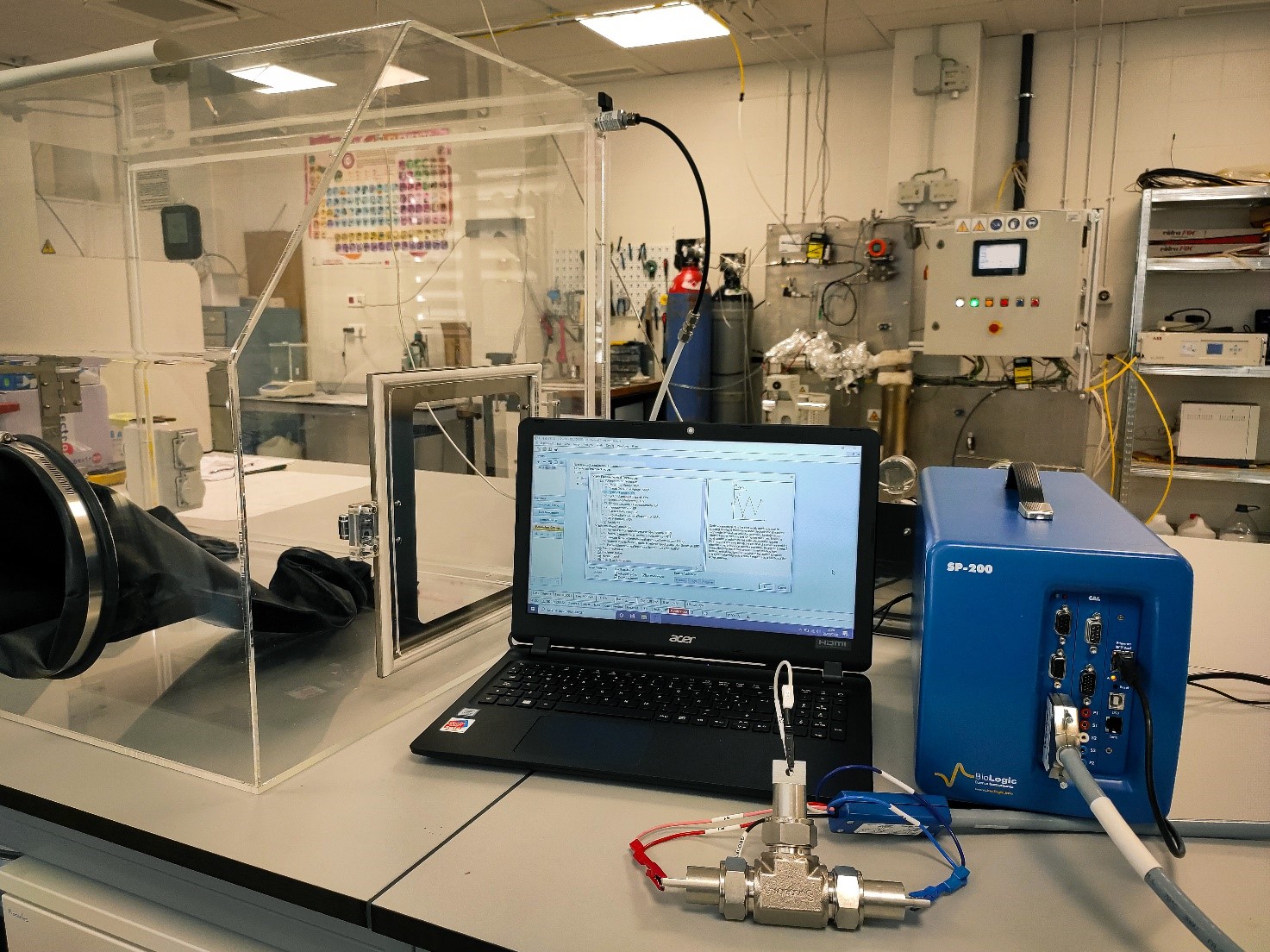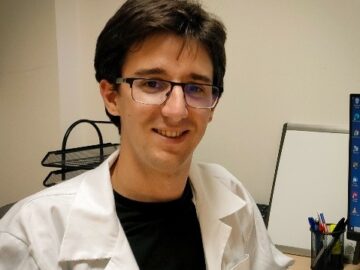SOBRE MÍ
Research Interests
- Producing biomass-derived chars by pyrolysis of agricultural wastes.
- Developing advanced carbon materials for thermal, catalytic and electrochemical applications.
- Activation and doping of engineered carbons as anodes for sodium-ion batteries.
Proyectos
- MEDWASTE —Mediterranean Agricultural Wastes: Environmentally Sustainable Resource for an Innovative Renewable Energy Technology (PCIN-2017-048)
- BIOCARB-ion —Engineered biochar-derived carbons as anodes for sodium- and potassium-ion batteries (PID2019-107737RB-I00)

PUBLICATIONS
2025
Antorán, Daniel; Alvira, Darío; Sebastián, Víctor; Manyà, Joan Josep
Scalable synthesis of heteroatom-doped carbons from waste hemp hurd with enhanced sodium-ion and potassium-ion storage capabilities Artículo de revista
En: Biomass and Bioenergy, vol. 194, pp. 107633, 2025, ISSN: 0961-9534.
@article{antoran_scalable_2025,
title = {Scalable synthesis of heteroatom-doped carbons from waste hemp hurd with enhanced sodium-ion and potassium-ion storage capabilities},
author = {Daniel Antorán and Darío Alvira and Víctor Sebastián and Joan Josep Manyà},
url = {https://www.sciencedirect.com/science/article/pii/S0961953425000443},
doi = {10.1016/j.biombioe.2025.107633},
issn = {0961-9534},
year = {2025},
date = {2025-03-01},
urldate = {2025-03-01},
journal = {Biomass and Bioenergy},
volume = {194},
pages = {107633},
abstract = {In this study, we applied an easily scalable two-step process comprising hydrothermal pretreatment with simultaneous mild heteroatom doping (N, N-S, and N-P) followed by carbonization at 800 °C to synthesize hard carbons (HCs) from waste hemp hurd for Na-ion and K-ion storage. The proposed synthesis pathway represents a viable alternative to the more energy-intensive, environmentally harmful, and/or challenging to scale up processes reported in the literature. The resulting carbons, particularly the dual NP-doped and single N-doped varieties, demonstrated improved electrochemical performance in terms of specific capacity (indicating more reversible ion storage sites) and rate capability (reflecting faster ion transport kinetics). These enhancements can be attributed to structural and surface chemistry modifications introduced during hydrothermal pretreatment. For Na-ion storage, the N-doped HC achieved a specific capacity of 293.6 mAh g−1 at 0.1 A g−1 (and 125 mAh g−1 at 1 A g−1) with an initial coulombic efficiency (ICE) of 73.5 % using an ester-based electrolyte. The same material showed an enhanced rate capability when an ether-based electrolyte was employed, achieving 155 mAh g−1 at 1 A g−1. For K-ion half-cells, the dual N-P-doped HC exhibited the best performance at low current rates, delivering a specific capacity of 260 mAh g−1 at 0.1 A g−1 in ester-based electrolytes. However, the N-doped HC showed the best rate capability at 2 A g−1 (57 mAh g−1), which is a reasonable value given the lack of mesopores in produced HCs.},
keywords = {},
pubstate = {published},
tppubtype = {article}
}
Alvira, Darío; Antorán, Daniel; Darjazi, Hamideh; Elia, Giuseppe Antonio; Gerbaldi, Claudio; Sebastian, Víctor; Manyà, Joan Josep
High performing and sustainable hard carbons for Na-ion batteries through acid-catalysed hydrothermal carbonisation of vine shoots Artículo de revista
En: Journal of Materials Chemistry A, vol. 13, no 4, pp. 2730–2741, 2025, ISSN: 2050-7496, (Publisher: The Royal Society of Chemistry).
@article{alvira_high_2025,
title = {High performing and sustainable hard carbons for Na-ion batteries through acid-catalysed hydrothermal carbonisation of vine shoots},
author = {Darío Alvira and Daniel Antorán and Hamideh Darjazi and Giuseppe Antonio Elia and Claudio Gerbaldi and Víctor Sebastian and Joan Josep Manyà},
url = {https://pubs.rsc.org/en/content/articlelanding/2025/ta/d4ta07393b},
doi = {10.1039/D4TA07393B},
issn = {2050-7496},
year = {2025},
date = {2025-01-01},
urldate = {2025-01-01},
journal = {Journal of Materials Chemistry A},
volume = {13},
number = {4},
pages = {2730–2741},
abstract = {This study investigates the synthesis of hard carbons via acid-assisted hydrothermal carbonisation (HTC) of vine shoots, followed by thermal annealing, to be used as Na-ion battery anodes. Various carbons with diverse pore structures, ordering degrees, 2D morphologies, and chemical compositions are obtained using 2 mol dm−3 solutions of HNO3, HCl, H2SO4, or H3PO4 as the hydrothermal media. Compared to standard ester-based liquid electrolytes, the use of a diglyme-based electrolyte (NaPF6/DGM) substantially boosts both the initial coulombic efficiency (ICE) and the specific capacity, particularly evident with the highly ordered and porous H3PO4-1000 and HCl-1000 carbons. These materials exhibit outstanding performance, storing 200 mAh g−1 at 2 A g−1 and showing ICE values of 68% and 77%, respectively. The improved stability and capacity are attributed to the formation of a more stable and thinner solid electrolyte interface (SEI), along with sodium storage into graphitic regions through a solvent co-intercalation reaction. While ester-based electrolytes limit hard carbon mesoporosity and require the promotion of turbostratic domains, ether-based electrolytes enable the development of more ordered and porous carbons, enhancing transport kinetics, sodium storage capacity, and electrode stability. Overall, acid-catalysed HTC offers a sustainable pathway for tailoring hard carbon based electrodes, repurposing biomass residues into valuable materials for green and low-cost energy storage applications.},
note = {Publisher: The Royal Society of Chemistry},
keywords = {},
pubstate = {published},
tppubtype = {article}
}
2024
Alvira, Darío; Antorán, Daniel; Darjazi, Hamideh; Elia, Giuseppe Antonio; Sebastian, Victor; Manyà, Joan Josep
Sustainable conversion of vine shoots and pig manure into high-performance anode materials for sodium-ion batteries Artículo de revista
En: Journal of Power Sources, vol. 614, pp. 235043, 2024, ISSN: 0378-7753.
@article{alvira_sustainable_2024,
title = {Sustainable conversion of vine shoots and pig manure into high-performance anode materials for sodium-ion batteries},
author = {Darío Alvira and Daniel Antorán and Hamideh Darjazi and Giuseppe Antonio Elia and Victor Sebastian and Joan Josep Manyà},
url = {https://www.sciencedirect.com/science/article/pii/S0378775324009959},
doi = {10.1016/j.jpowsour.2024.235043},
issn = {0378-7753},
year = {2024},
date = {2024-09-01},
urldate = {2024-09-01},
journal = {Journal of Power Sources},
volume = {614},
pages = {235043},
abstract = {Sodium-ion batteries (SIBs) are considered promising candidates for future grid energy storage, with hard carbons emerging as key commercial anode materials. This study presents a novel approach to synthesize N-doped hard carbons via co-hydrothermal treatment of vine shoots and pig manure and subsequent thermal annealing of the resulting hydrochar. This method enhances the development of micro- and ultra-microporosity in the synthesized hard carbons, with nitrogen, and to a lesser extent phosphorus and sulfur, introduced as doping elements. Furthermore, the incorporation of hydrochloric acid during the hydrothermal step promotes biomass hydrolysis, leading to increased mesoporosity and the formation of microsphere clusters. In the realm of electrochemical performance, an investigation into various ester- and ether-based electrolytes has revealed NaPF6 in diglyme as the best formulation, thanks to its thinner and more stable solid electrolyte interface (SEI). Using this electrolyte, the best-performing electrode showed an initial Coulombic efficiency (ICE) of 73 %, with reversible capacities of 239, 180, 86, and 57 mAh g−1 at 0.1, 1, 5, and 10 A g−1, respectively. In addition, the electrode exhibited a remarkable capacity retention of 88 % after 250 cycles as well as a compatible behavior when paired with a NVPF-based cathode.},
keywords = {},
pubstate = {published},
tppubtype = {article}
}
Antorán, Daniel; Alvira, Darío; Sebastián, Víctor; Manyà, Joan Josep
Enhancing waste hemp hurd-derived anodes for sodium-ion batteries through hydrochloric acid-mediated hydrothermal pretreatment Artículo de revista
En: Biomass and Bioenergy, vol. 184, pp. 107197, 2024, ISSN: 0961-9534.
@article{antoran_enhancing_2024,
title = {Enhancing waste hemp hurd-derived anodes for sodium-ion batteries through hydrochloric acid-mediated hydrothermal pretreatment},
author = {Daniel Antorán and Darío Alvira and Víctor Sebastián and Joan Josep Manyà},
url = {https://www.sciencedirect.com/science/article/pii/S0961953424001508},
doi = {10.1016/j.biombioe.2024.107197},
issn = {0961-9534},
year = {2024},
date = {2024-05-01},
urldate = {2024-05-01},
journal = {Biomass and Bioenergy},
volume = {184},
pages = {107197},
abstract = {Waste hemp hurd (WHH) was used as a sustainable feedstock for producing hard carbon-based anodes for sodium-ion batteries (SIBs). Two easily scalable production pathways were tested and compared: (1) pyrolysis (at 500 °C) and subsequent annealing at 800, 1000 or 1200 °C, and (2) hydrothermal pretreatment (at 180 °C) and subsequent annealing at the above-mentioned highest temperatures. Results indicated that when a HCl (2 mol m−3) aqueous solution was used as hydrothermal medium, the textural, structural and surface chemistry features linked to the electrochemical performance of the resulting hard carbons improved. The WHH-derived electrode produced via HCl-mediated hydrothermal pretreatment and subsequent annealing at 1000 °C showed an exceptional electrochemical performance in terms of specific capacity (535 mA h g−1 at 30 mA g−1) and rate capability (372, 156, 115, and 83 mA h g−1 at 0.1, 0.5, 1, and 2 A g−1, respectively) when an ester-based electrolyte was used (NaTFSI in EC/DMC). Using an ether-based electrolyte (NaPF6 in diglyme) improved both the ICE (from 69% to 78%) and cycling stability (85% of capacity retention after 300 cycles at 1 A g−1; 91% when current rate returned to 0.1 A g−1). In summary, relatively low-cost WHH-derived carbons are able to deliver an exceptional performance, much better than that reported so far for other biomass-derived carbons, and even close to that exhibited by more expensive and complex composite and hybrid materials.},
keywords = {},
pubstate = {published},
tppubtype = {article}
}
2023
Alvira, Darío; Antorán, Daniel; Vidal, Mariano; Sebastián, Víctor; Manyà, Joan Josep
Vine Shoots-Derived Hard Carbons as Anodes for Sodium-Ion Batteries: Role of Annealing Temperature in Regulating Their Structure and Morphology Artículo de revista
En: Batteries & Supercaps, vol. n/a, no n/a, pp. e202300233, 2023, ISSN: 2566-6223, (_eprint: https://onlinelibrary.wiley.com/doi/pdf/10.1002/batt.202300233).
@article{alvira_vine_nodate,
title = {Vine Shoots-Derived Hard Carbons as Anodes for Sodium-Ion Batteries: Role of Annealing Temperature in Regulating Their Structure and Morphology},
author = {Darío Alvira and Daniel Antorán and Mariano Vidal and Víctor Sebastián and Joan Josep Manyà},
url = {https://onlinelibrary.wiley.com/doi/abs/10.1002/batt.202300233},
doi = {10.1002/batt.202300233},
issn = {2566-6223},
year = {2023},
date = {2023-08-02},
urldate = {2023-08-02},
journal = {Batteries & Supercaps},
volume = {n/a},
number = {n/a},
pages = {e202300233},
abstract = {Sodium-ion batteries (SIBs) are considered one of the most promising large-scale and low-cost energy storage systems due to the abundance and low price of sodium. Herein, hard carbons from a sustainable biomass feedstock (vine shoots) were synthesized via a simple two-step carbonization process at different highest temperatures to be used as anodes in SIBs. The hard carbon produced at 1200 °C delivered the highest reversible capacity (270 mAh g−1 at 0.03 A g−1, with an acceptable initial coulombic efficiency of 71 %) since a suitable balance between the pseudographitic domains growth and the retention of microporosity, defects, and functional groups was achieved. A prominent cycling stability with a capacity retention of 97 % over 315 cycles was also attained. Comprehensive characterization unraveled a three-stage sodium storage mechanism based on adsorption, intercalation, and filling of pores. A remarkable specific capacity underestimation of up to 38 % was also found when a two-electrode half-cell configuration was employed to measure the rate performance. To avoid this systematic error caused by the counter/reference electrode polarization, we strongly recommend the use of a three-electrode setup or a full-cell configuration to correctly evaluate the anode response at moderate and high current rates.},
note = {_eprint: https://onlinelibrary.wiley.com/doi/pdf/10.1002/batt.202300233},
keywords = {},
pubstate = {published},
tppubtype = {article}
}


